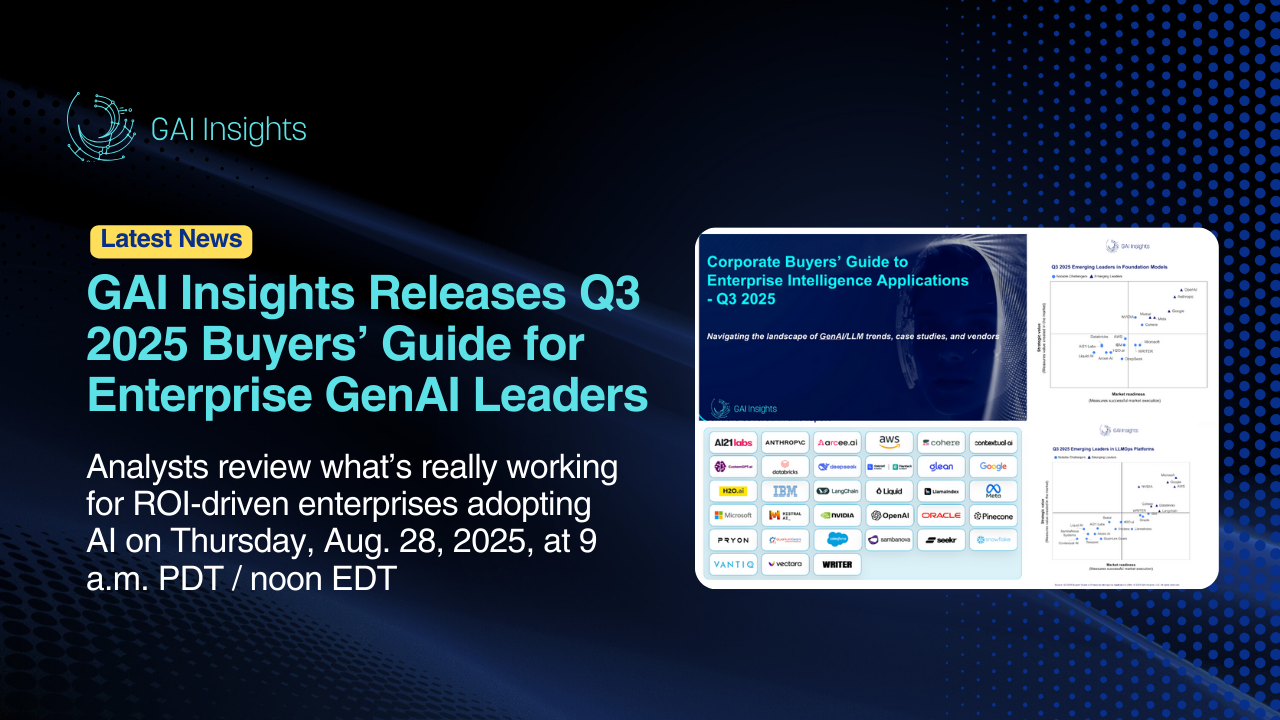Generative AI has moved past experimentation and into strategic focus. Enterprises are launching pilots, building prototypes, and hitting a wall. The real challenge in 2025 isn’t starting GenAI, it’s scaling it.
Across industries, organizations are struggling to cross the chasm from isolated successes to enterprise-wide deployment. This organizational chasm mirrors the one Geoffrey Moore described in technology markets: between early pilot success and widespread adoption. In GenAI, it’s the space between what a team can prove in a sandbox and what an enterprise can operationalize at scale.
Our updated Q2 2025 Buyer’s Guide to Enterprise Intelligence Applications is designed to help teams bridge that gap. It diagnoses why scaling stalls and equips leaders to make clearer, faster, and more confident decisions.

Inside the Chasm: What’s Blocking Scale
1. Lack of Strategic Alignment and Prioritization Frameworks
Business and tech teams are running isolated pilots without alignment on where GenAI will create value. Use cases multiply, but without structured prioritization or KPI tracking, few progress beyond experimentation. Leadership support wanes when results stay disconnected from business goals.
2. Operational Gaps in Infrastructure and Model Lifecycle Management
As models move from sandbox to production, integration gaps surface. Enterprises are realizing their data pipelines, monitoring tools, and governance processes aren’t built for continuous GenAI workloads. Latency issues, hallucinations, and model drift appear—but few have the operational maturity to manage them.
3. Fragmented Vendor Ecosystem and Unclear Evaluation Criteria
The vendor ecosystem is evolving faster than enterprise procurement cycles can track. With foundation models, open-source tools, vertical platforms, and agent frameworks all competing for attention, many teams are stuck in comparison mode. Fear of lock-in, lack of interoperability, and unclear TCO make vendor decisions harder and slower.
4. Escalating Architectural Complexity Due to Rapid Innovation
Enterprises that just finished piloting basic LLMs are now being pushed to evaluate reasoning engines and agentic frameworks. While these advances offer new capabilities, they also add layers of architectural complexity, testing requirements, and failure modes. The gap between what’s possible and what’s manageable is widening.
5. Organizational Readiness Gaps in Trust, Training, and Governance
Even as tools roll out, employee adoption lags. Many users don’t trust GenAI outputs or don’t understand how to incorporate them into their workflows. Meanwhile, concerns around data security, IP protection, and compliance are becoming louder as GenAI touches regulated and customer-facing processes. Governance, training, and change management aren’t keeping pace.
Inside the Q2 2025 Buyer’s Guide: What’s New and Why It Matters
The updated Buyer’s Guide isn’t just an index of tools—it’s a decision-support framework grounded in real scaling lessons. As enterprise adoption accelerates, the gap between ambition and execution is growing. This edition of the guide closes that gap with actionable insight at every stage of GenAI maturity.
Here’s how the Q2 2025 edition equips enterprises to move forward with clarity and confidence:
Stage-Based Playbooks for Adoption
The guide outlines how GenAI-related challenges evolve across four enterprise stages—starting out, post-pilot, in production, and scaled rollout. For each stage, it recommends appropriate deployment models, data-readiness tactics, and operating frameworks. These stage-based playbooks help teams avoid the drop-off between early promise and enterprise-wide value, the organizational chasm where many GenAI efforts stall.
Use Case Maturity Benchmarks
Drawing on examples from functions like customer support, software engineering, legal, and marketing, the guide benchmarks enterprise use cases across levels of adoption. Each profile highlights business impact, tooling approaches, and lessons from peers—helping teams assess where they are and where they could go next.
Strategic Trends to Watch
The GenAI landscape is shifting quickly—from general-purpose LLMs to reasoning models, vertical AI platforms, and emerging agent frameworks. The guide clarifies which trends are gaining enterprise traction, which remain experimental, and how to evaluate their relevance without overcommitting resources.
Our updated Buyer’s Guide is designed to help enterprises bridge this internal scaling chasm, by turning proof-of-concept wins into scalable, compliant, and strategically aligned GenAI deployments.
Translating the Vendor Landscape Into Strategic Choices
Procurement teams need more than feature lists. This guide makes vendor selection strategic.
- Foundation Model 2x2: A comparative grid evaluating top models by reasoning performance and cost efficiency—helping buyers align model choice with use case complexity and budget constraints.
- LLMOps 2x2: A parallel grid mapping vendors based on orchestration capabilities and observability maturity—key to ensuring sustainable, scalable GenAI operations.
- Vendor Profiles: Over 30 vendors are profiled with updates on Q2 product launches, architectural shifts, and capability strengths and limitations—giving buyers a clear view of what’s new, what’s stable, and what to watch.
From Noise to Navigation
The GenAI ecosystem isn’t short on options—it’s short on structure. The Q2 2025 Buyer’s Guide is designed to help leaders cut through volatility and make execution-ready decisions. It connects enterprise challenges to deployment strategies, operating models, and vendor choices in a way that scales with your ambition.




